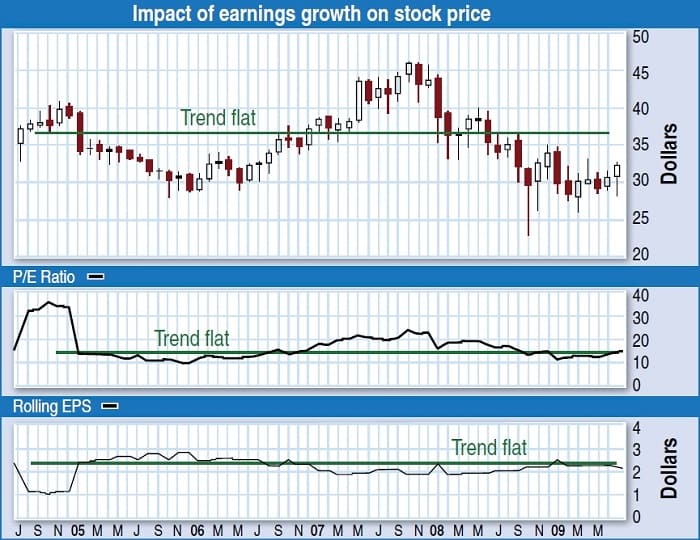Articles
GEMs Among The Talus By Thomas Maskell

In my book The Complete Guide To Investing During Retirement, I discussed the three Rs that move a stock price: reason, recognition, and reaction. In order for a stock price to move, there must be a reason; the market must recognize that reason and the market must react to it. When all three Rs are operating, price movements, either up or down, are initiated and sustained. Today, we are going to focus on just one of those Rs — the reason.
What are the fundamental reasons behind a stock price move? Stock prices move for one or more of three reasons — growth, earnings, and money flow (or, if you prefer, momentum), better known as Gems. These are the legitimate reasons prices move. There are other reasons that can move a stock, but we are just going to focus on the legitimate reasons.
Growth

J S N 05 M M J S N 06 M M J S N 07 M M J S N 08 M M J S N 09 M M FIGURE 1: EARNINGS GROWTH AND STOCK PRICE. If a company’s earnings are growing, its stock price will also grow. As the earnings per share trends upward, the stock price also trends upward.
More than any other reason, growth drives stock prices. If a company is growing its earnings, its stock price will also grow. A look at Figure 1 illustrates the point. As the earnings per share (eps) trends upward, the stock price also trends upward. Take away the growth in earnings, as in Figure 2, and stock price tends to stagnate.

FIGURE 2: NO GROWTH, NO GAIN. If there’s no growth in earnings, prices tend to stagnate.
One of the reasons growth is such a strong indicator of price movements is its multiplier effect. Growth affects stock prices in two ways. It affects price directly by pushing the price up, and it affects price indirectly by changing how investors view the stock. Investors believe growth stocks are worth more than mature stocks, and this viewpoint is reflected in the stock’s price/earnings ratio (P/E).
The impact of this multiplier is impressive. For example, a company with a $1.00 eps and a growth rate of 10% and a comparable P/E of 10 would have a stock price of $10. If the company continued that growth track, within a year the eps would be $1.10 and the stock price would be $11. Double that growth rate to 20% and with a similar P/E (10), the new stock price would be $12. If based on the new growth rate the market would change its view of the stock (P/E = 20), the new price would be $22, a 120% gain. Truly, growth is the premier intermediate-term price driver.
Earnings
In the old days, stock experts attempted to value stocks based on dividends paid, but they soon discovered that the market didn’t. So they adjusted their valuation models to reflect the potential to pay dividends, which are earnings or eps. Thus, the P/E was born, which when inversed is the current potential rate of return on your stock purchase.
That last statement may require an explanation. The P/E (price/earnings per share) of the first example is 10 ($10/$1). Inversing it gives us a rate of return of 0.10 or 10% ([$1/$10] x 100), which means for every $10 you invest in the company, you gain $1 in earnings. Of course, the company isn’t paying you the whole $1, which is why it is only your potential rate of return. In addition, since it is what the company is earning today, it is the current, potential return. Note that a P/E of 10, which is within range of the market average of 10 to 15 (a 10% to 7% return), compares favorably to less risky investments such as bonds and bank accounts (a 5% to 3% return).
Suggested Books and Courses About Investment
As stock buyers anticipate growth in earnings, a stock price can get ahead of itself. In the second example, if buyers anticipated a 20% growth rate and bid the P/E up to 20, the resulting rate of return would be just 5% based on current earnings. Without earnings growth, high P/Es, which indicate low rates of return, would be an irrational development in a supposedly rational market.
While earnings are clearly linked to stock prices over the long term, there are, as mentioned, other factors that distort the relationship. These include the growth, stability, and risk associated with the earnings. These other factors diminish the value of P/E as a universal determinant of stock price. In fact, P/E is best viewed as a result of these factors rather than as a price driver. In essence, stock prices do not rise because of a low P/E. They have a low P/E because the stock price is not expected to rise.
Before we leave earnings, we should mention some other valuation methods that are used by the market such as price to cash flow (P/CF), price to sales (P/S), and price to book value (P/BV). They all have just enough legitimacy to make them dangerous. For instance, P/S was the primary reason we had a tech bubble. The experts told us to ignore earnings and focus on sales, and they turned out to be wrong. P/BV is downright silly; as a common shareholder, you run the danger of getting nothing from the assets of a company if it liquidates. As far as cash flow is concerned, cash without profits is treading water. Companies survive on cash, but they grow with profits. If you invest in stocks based on these valuation methods, don’t expect much, because you are not going to get much.
While the stock market is filled with rubble, with some analysis, the astute investor can uncover some valuable GEMs.
Money Flow
While earnings and growth are excellent long-term predictors of stock prices, there is an 800-pound gorilla in the room called money flow. When money flow roars, your stock’s price will either jump or cower.

FIGURE 3: MONEY FLOW AND STOCK PRICE. Note that with each drop of the DJIA, the price of the stock is affected, even though the earnings are still strong and the growth trend is positive. The stock is simply swept up into the market’s currents.
In Figure 3, I used the movement of the Dow Jones Industrial Average (Djia) as a surrogate for money flow because the recent downturn clearly illustrates the point. However, this flow effect can also be sector oriented or stock focused. Whatever the extent of the flow, its ability to drag down the price of a healthy stock is dramatic. In Figure 3, with each drop of the Djia, the price of the stock is affected. Note that earnings are still strong and the growth trend is positive. The stock is simply swept up into the market’s currents.
Money flow is an area where the astute trader can seize some lucrative opportunities. By monitoring various money flow metrics, the trader can move in and out of the market with each buy and sell signal. For those investors who watched their 401Ks dwindle, this may be a good time to consider a trading strategy. But money flow is not just for traders. Value investors can certainly find opportunity in a healthy stock that is being pushed around by a panicky market. The stock in the example given would appear to be a good candidate for a value play.
Even the growth investor might find a stock or two that has maintained its sales and earnings growth but has fallen victim to a negative money flow. This can be viewed as a simple pullback, albeit more dramatic. Pullbacks are a classic entry point for a company on a strong growth uptrend.
Uncovering The GEMs
While the stock market is filled with rubble, with a little analysis, the astute investor can uncover some valuable Gems. Look for growth, earnings, and money flow. Anyone can yield profits. Finding all three Gems, however, could make you wealthy.
